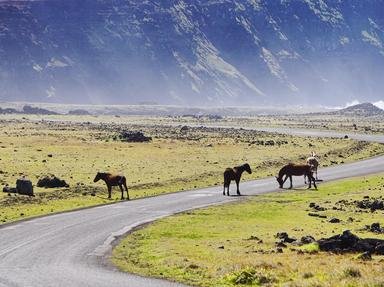Quiz Answer Key and Fun Facts
1. As most visitors do, I land at Santiago's Airport after a grueling 20 hour flight. Santiago is the heart and soul of the country. It's by far the biggest city and, being founded in 1541, also the oldest. It was founded at...?
2. First travelling west I want to visit the historically most important port of Chile: Valparaiso. Directly adjacent to this city is another, actually larger city. What is this city's name?
3. Finally we turn to the North. Chileans are very practical when talking about Chile north of Santiago; they simply call it 'El Norte'. The northern part is called 'El Norte Grande'. What is the southern part called?
4. The trip to the North is about 24 hours and I take the night bus to Antofagasta. North of Copiapo the desert begins in earnest and its dull, dull, dull. So when in the middle of nowhere I suddenly see this man made structure I think I am looking at a mirage. What am I seeing?
5. In Calama I miss the last bus to my destination San Pedro, so I am stranded. Calama is the only sizable settlement on Chile's longest river. What is it called?
6. At last I reach the tourism capital of northern Chile: San Pedro de Atacama. I am surprised by the smallness of it and reminds me of the Mexican towns in western movies, only the tumbleweed is missing. The village lies on the edge of Chiles largest 'salar'(= salt lake). What is its name?
7. The area around San Pedro is full of natural beauty but the most impressive site (personal opinion), Tatio, is a two hours drive over dirt roads away. For what is Tatio famous?
8. Tectonics 101: Our home planet (aka earth) is made of huge slabs, continent size. When they hit each other head on one slab goes up making the highest mountains, one slab goes down forming a deep sea trench and all kind of mayhem happens: earthquakes, tsunamis and volcanic eruptions scourge the country. I have been talking about volcanoes and mountains already and though i didn't mention them until now, earthquakes are a daily nuisance to Chileans. Measuring 9.5 on the Richter scale, the strongest earthquake of the 20th century occurred in southern Chile in late May 1960, killing about 5,000. In the case of Chile the slab going up is South America, the slab going down is called the Nazca plate. The resulting mountains are the Andes, but what is the trench called?
9. It's almost time to return to the south and I pass by Calama again. Close by is a small town with the name Chuquicamata (sometimes Chiquicamata). It is famous for being the world's largest open-pit mine. What is being mined here?
10. On my way back to Santiago I stop at La Serena to chill. Founded in 1544 it's Chile's second oldest city. Situated only a couple of kilometers from the coast it is tied to the city of Coquimbo, connected/separated by 5km (3 mi) of beach where every summer vacation (February) hordes of Chileans, Argentines and Brazilians crowd the hotels which are empty the rest of the year. Doing some sightseeing in both cities I notice the differences in the twin cities: La Serena is an administrative center with Universities, Coquimbo is a harbor and industrial town. The twins are very different except for one feature which all Chilean cities seem to share. Which one?
Source: Author
triviapaul
This quiz was reviewed by FunTrivia editor
minch before going online.
Any errors found in FunTrivia content are routinely corrected through our feedback system.

